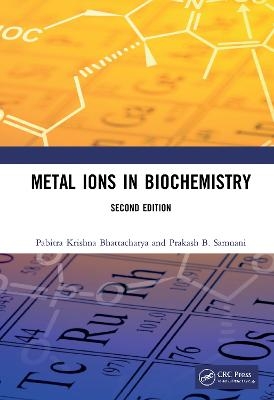
Metal Ions in Biochemistry
CRC Press (Verlag)
978-0-367-62225-1 (ISBN)
The second edition of Metal Ions in Biochemistry deals with the multidisciplinary subject of bio-inorganic chemistry, encompassing the disciplines of inorganic chemistry, biochemistry and medicine.
The book deals with the role of metal ions in biochemistry, emphasising that biochemistry is mainly the chemistry of metal-biochemical complexes. Hence, the book starts with the structures of biochemicals and the identification of their metal binding sites. Thermodynamic and kinetic properties of the complexes are explained from the point of view of the nature of metal-ligand bonds. Various catalytic and structural roles of metal ions in biochemicals are discussed in detail.
Features
The role of Na+ and K+ in brain chemistry.
The role of zinc insulin in glucose metabolism and its enhancement by vanadium and chromium compounds.
Discussion of the role of zinc signals, zinc fingers and cascade effect in biochemistry.
Haemoglobin synthesis and the role of vitamin B12 in it.
The role of lanthanides in biochemical systems.
A detailed discussion of the role of non-metals in biochemistry, a topic missing in most of the books on bio-inorganic chemistry.
The study of bio-inorganic chemistry makes biochemists rethink the mechanistic pathways of biochemical reactions mediated by metal ions. There is a realisation of the role of metal complexes and inorganic ions as therapeutics such as iron in leukaemia, thalassemia and sickle cell anaemia, iodine in hypothyroidism and zinc, vanadium and chromium in glucose metabolism. The most recent realisation is of the use of zinc in the prevention and treatment of COVID-19.
Pabitra Krishna Bhattacharya retired as Professor and Head, Department of Chemistry, M S University of Baroda, 9m 2001, after serving for thirty four years. Prior to that, he served in Kurukshetra University, University of Rajasthan (Jaipur), and Vikram University (Ujjain). Prof Bhattacharya obtained MSc and PhD degrees from University of Saugor, MP. He was awarded senior fellowship under Fulbright Hayes programme to carry out post doctoral work in Ohio state University Columbus USA during 1976 – 77. He also worked in University of Sheffield UK in 1987 under INSA Royal Society Exchange Programme. Prof Bhattacharya’s teaching and research interests involved quantum chemistry, spectroscopy, coordination chemistry, bioinorganic chemistry and homogeneous catalysis. Thirty seven students obtained PhD degree under his supervision. He presented papers and delivered lectures at various Indian and foreign conferences. He was invited as a speaker at international conference in coordination chemistry, held at Gera, Germany in 1990. Prof Bhattacharya was awarded Prof P Ray memorial medal of Indian Chemical Society in 2000, Platinum Jubilee lecture award of Science Congress in 2001 and Silver medal of Chemical Research Society of India, Bangalore, 2002. He worked as a member of various committees, more notable being, IUPAC, and DST, programme advisory committee. Prof Bhattacharya is the author of three books, Group theory and its Chemical Applications, published by Himalaya Publishing House, Mumbai, Metal Ions in Biochemistry, First Edition, by Narosa Publisher, Delhi, and Threshold of Inorganic Chemistry, 1st edition, published by Himalaya Publishing House, Mumbai. Prakash B Samnani obtained his MSc and PhD degrees from The Maharaja Sayajirao University of Baroda, Vadodara. After a 2 years stint as Research Officer in Analytical Division of the Advanced Research Center of Sun Pharmaceuticals, he joined the Department of Chemistry of the M S University of Baroda where he is presently working as Professor. With the industrial experience and more than 25 years of teaching and research experience in Chemistry in the University, the author has a number of research publications to his credit. He has published research papers in the area of Analytical Chemistry and Homogeneous Catalysis in journals of National and International repute. He has also authored five books titled Experiments in Chemistry, Chemical Companion, Teaching of Chemical Analysis, Quantitative Chemical Analysis, and Threshold of Inorganic Chemistry, all published by well known publishing houses in India. He has completed research projects funded by UGC, CSIR, DST. His teaching and research interests include Inorganic Chemistry, Analytical Chemistry, especially Chromatographic methods, Environmental Chemistry and Homogeneous Catalysis.
1. Structure of Cells and Introduction to Bioinorganic Chemistry................................................. 1
2. Thermodynamic and Kinetic Properties of Metal Complexes....................................................17
3 Alkali and Alkaline Earth Metal Ions in Biochemical Systems................................................. 63
4. Zinc in Biochemical Systems.......................................................................................................... 83
5. Iron in Biochemical Systems........................................................................................................ 103
6. Copper in Biochemical Systems................................................................................................... 139
7. Cobalt in Vitamin B12 in Biochemical System............................................................................ 157
8. Molybdenum in Nitrogen Fixation in Plants...............................................................................167
9. Magnesium and Manganese in Photosynthesis in Plants...........................................................177
10. Less Common Trace Metal Ions in Biochemical Systems..........................................................187
11. Metal Ion Toxicity in Biochemical Systems................................................................................ 209
12. Metal Complexes in Therapeutics................................................................................................219
13. Role of Trace Nonmetals in Biochemical Systems......................................................................231
| Erscheinungsdatum | 15.01.2021 |
|---|---|
| Zusatzinfo | 2 Tables, black and white; 190 Illustrations, black and white |
| Verlagsort | London |
| Sprache | englisch |
| Maße | 178 x 254 mm |
| Gewicht | 698 g |
| Themenwelt | Naturwissenschaften ► Biologie ► Biochemie |
| Naturwissenschaften ► Chemie ► Anorganische Chemie | |
| Technik ► Umwelttechnik / Biotechnologie | |
| ISBN-10 | 0-367-62225-4 / 0367622254 |
| ISBN-13 | 978-0-367-62225-1 / 9780367622251 |
| Zustand | Neuware |
| Haben Sie eine Frage zum Produkt? |
aus dem Bereich


